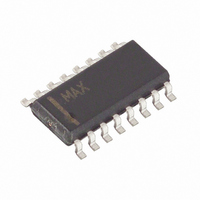DS1808Z-050 Maxim Integrated Products, DS1808Z-050 Datasheet - Page 5

DS1808Z-050
Manufacturer Part Number
DS1808Z-050
Description
IC POT DUAL LOG HV 50K 16-SOIC
Manufacturer
Maxim Integrated Products
Datasheet
1.DS1808Z-050.pdf
(17 pages)
Specifications of DS1808Z-050
Taps
32
Resistance (ohms)
45K
Number Of Circuits
2
Temperature Coefficient
750 ppm/°C Typical
Memory Type
Volatile
Interface
I²C, 2-Wire Serial
Voltage - Supply
4.5 V ~ 5.5 V, ±4.5 V ~ 13.2 V
Operating Temperature
-40°C ~ 85°C
Mounting Type
Surface Mount
Package / Case
16-SOIC (3.9mm Width)
Resistance In Ohms
45K
Lead Free Status / RoHS Status
Contains lead / RoHS non-compliant
Available stocks
Company
Part Number
Manufacturer
Quantity
Price
Part Number:
DS1808Z-050
Manufacturer:
DALLAS
Quantity:
20 000
2-WIRE SERIAL PROTOCOL
The following bus protocol has been defined:
§ Data transfer may be initiated only when the bus is not busy.
§ During data transfer, the data line must remain stable whenever the clock line is high. Changes in the
Accordingly, the following bus conditions have been defined:
Bus not busy: Both data and clock lines remain high.
Start data transfer: A change in the state of the data line from high to low while the clock is high
defines a start condition.
Stop data transfer: A change in the state of the data line from low to high while the clock line is high
defines the stop condition.
Data valid: The state of the data line represents valid data when, after a start condition, the data line is
stable for the duration of the high period of the clock signal. The data on the line can be changed during
the low period of the clock signal. There is one clock pulse per bit of data. Figures 2 and 3 detail how
data transfer is accomplished on the two-wire bus. Depending upon the state of the R/W bit, two types of
data transfer are possible.
Each data transfer is initiated with a start condition and terminated with a stop condition. The number of
data bytes transferred between start and stop conditions is not limited and is determined by the master
device. The information is transferred byte-wise and each receiver acknowledges with a 9
Within the bus specifications a regular mode (100kHz clock rate) and a fast mode (400kHz clock rate) are
defined. The DS1808 works in both modes.
Acknowledge: Each receiving device, when addressed, is obliged to generate an “acknowledge” after the
reception of each byte. The master device must generate an extra clock pulse that is associated with this
acknowledge bit.
A device that acknowledges must pull down the SDA line during the acknowledge clock pulse in such a
way that the SDA line is a stable low during the high period of the acknowledge related clock pulse. Of
course, setup and hold times must be taken into account. A master must signal an end of data to the slave
by not generating an acknowledge bit on the last byte that has been clocked out of the slave. In this case,
the slave must leave the data line high to enable the master to generate the stop condition.
1. The following occurs when data is transferred from a master transmitter to a slave receiver. The first
2. The following occurs when data is transferred from a slave transmitter to a master receiver. The
data line while the clock line is high will be interpreted as control signals.
byte transmitted by the master is the command/control byte. Next follows a number of data bytes. The
slave returns an acknowledge bit after each received byte.
master transmits the first byte (the command/control byte) to the slave. The slave then returns an
acknowledge bit. Next, follows a number of data bytes transmitted by the slave to the master. The
master returns an acknowledge bit after all received bytes other than the last byte. At the end of the
last received byte, a “not acknowledge” can be returned.
5 of 17
th
bit.













